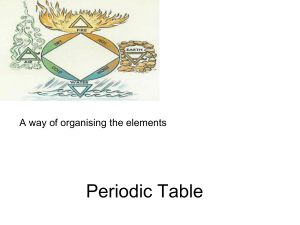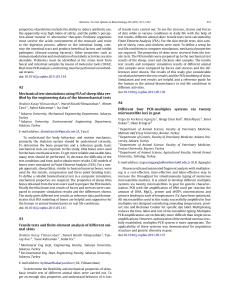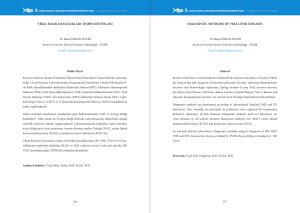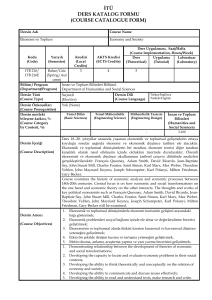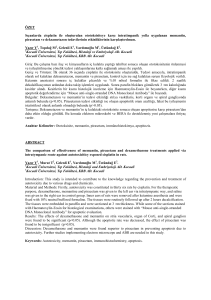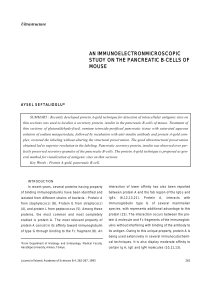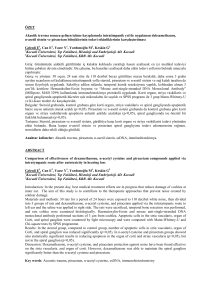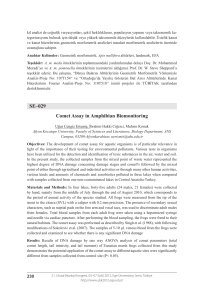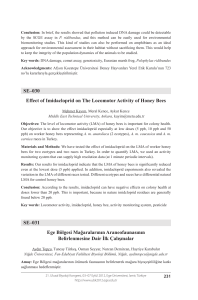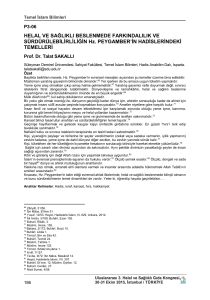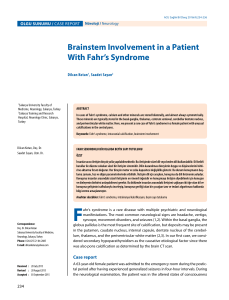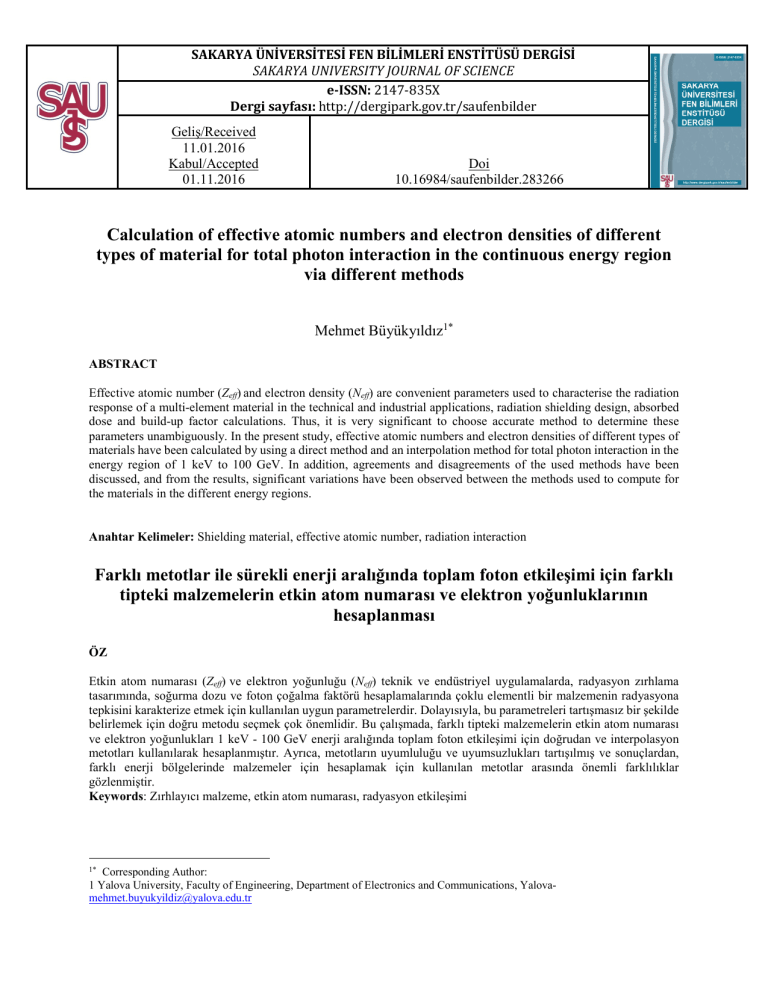
SAKARYA ÜNİVERSİTESİ FEN BİLİMLERİ ENSTİTÜSÜ DERGİSİ
SAKARYA UNIVERSITY JOURNAL OF SCIENCE
e-ISSN: 2147-835X
Dergi sayfası: http://dergipark.gov.tr/saufenbilder
Geliş/Received
11.01.2016
Kabul/Accepted
01.11.2016
Doi
10.16984/saufenbilder.283266
Calculation of effective atomic numbers and electron densities of different
types of material for total photon interaction in the continuous energy region
via different methods
Mehmet Büyükyıldız1*
ABSTRACT
Effective atomic number (Zeff) and electron density (Neff) are convenient parameters used to characterise the radiation
response of a multi-element material in the technical and industrial applications, radiation shielding design, absorbed
dose and build-up factor calculations. Thus, it is very significant to choose accurate method to determine these
parameters unambiguously. In the present study, effective atomic numbers and electron densities of different types of
materials have been calculated by using a direct method and an interpolation method for total photon interaction in the
energy region of 1 keV to 100 GeV. In addition, agreements and disagreements of the used methods have been
discussed, and from the results, significant variations have been observed between the methods used to compute for
the materials in the different energy regions.
Anahtar Kelimeler: Shielding material, effective atomic number, radiation interaction
Farklı metotlar ile sürekli enerji aralığında toplam foton etkileşimi için farklı
tipteki malzemelerin etkin atom numarası ve elektron yoğunluklarının
hesaplanması
ÖZ
Etkin atom numarası (Zeff) ve elektron yoğunluğu (Neff) teknik ve endüstriyel uygulamalarda, radyasyon zırhlama
tasarımında, soğurma dozu ve foton çoğalma faktörü hesaplamalarında çoklu elementli bir malzemenin radyasyona
tepkisini karakterize etmek için kullanılan uygun parametrelerdir. Dolayısıyla, bu parametreleri tartışmasız bir şekilde
belirlemek için doğru metodu seçmek çok önemlidir. Bu çalışmada, farklı tipteki malzemelerin etkin atom numarası
ve elektron yoğunlukları 1 keV - 100 GeV enerji aralığında toplam foton etkileşimi için doğrudan ve interpolasyon
metotları kullanılarak hesaplanmıştır. Ayrıca, metotların uyumluluğu ve uyumsuzlukları tartışılmış ve sonuçlardan,
farklı enerji bölgelerinde malzemeler için hesaplamak için kullanılan metotlar arasında önemli farklılıklar
gözlenmiştir.
Keywords: Zırhlayıcı malzeme, etkin atom numarası, radyasyon etkileşimi
1*
Corresponding Author:
1 Yalova University, Faculty of Engineering, Department of Electronics and Communications, [email protected]
M. Büyükyıldız
Calculation of effective atomic numbers and electron densities of different types of
material for total photon interaction in the continuous energy region via different
methods
1. INTRODUCTION
Radiation interaction with matter has become an
important subject with the extensive use of X and/or
gamma rays in various fields such as reactors, nuclear
power plants, nuclear engineering and space technology,
nuclear diagnostics, nuclear medicine, radiation
dosimetry and radiation biophysics, technological and
engineering applications. Because of the increasing
usage of the radiations, it should be noted the risks on
human health. Therefore, the use of shielding is very
important in the fields. To choose an appropriate type of
material, it should be determined radiation matter
interaction parameters such as mass attenuation
coefficient, effective atomic number and electron
density.
Effective atomic number (Zeff) is introduced firstly by
Hine [1]. Then, it has been developed by different
researchers. There are different available methods used
to compute Zeff for different type of materials such as
direct method [2-4], interpolation method [5, 6], ratio
cross-section method [7-16] and empirical method [1].
As a result, literature is rich of experimental as well as
theoretical studies regarding effective atomic number
and electron density, but there are a few studies dealing
with the comparison of the methods used to compute Zeff
and Neff in different materials [4,17]. Especially recently,
Elmahroug et al. determined radiation matter interaction
parameters of some shielding materials for total photon
interaction [15]. Mann et al. studied shielding behaviors
of some polymer and plastic materials for gamma-rays
[21]. Tapan et al. investigated pumice materials in
physical and chemical properties for shielding [22]. This
prompted us to focus on this study.
Our aim is to compare the direct method and
interpolation method commonly used to compute Zeff and
Neff in shielding, polymer, plastic and pumice materials
used in cement, concrete, brick, and ceramic industries as
an additive and aggregate material. The processes were
used both new materials (Sample 5-12) and well known
materials such as mylar film, PVS for total photon
interaction in the wide energy range from 1 keV to 100
GeV. The chemical compositions of the selected
materials have been given in Table 1 [15,21] and Table 2
[22].
Table 1. Chemical composition (%) of the shielding materials, Sample 1-4 [21] and Sample 5-12 [15].
Sample
Polyvinyl chloride
(PVC)
Air-equivalent plastic
(C-552)
Radio chromic dye film
(nylon base)
Polyethylene
terephthalate (mylar)
Flexi- Boron
7.5% Lithium
Polyethylene
8.97% Borated
Polyethylene
Self Extinguishing
Borated Polythylene
5.45% Borated
Polyethylene
High Temperature
Boron Silicone
Symbol
Elemental composition (% by weight)
S1
H(4.84),C(38.44),Cl(56.73)
S2
H(2.47),C(50.17),O(0.46),F(46.53),Si(0.40)
S3
H(10.20),C(65.44),N(9.89),O(14.47)
S4
H(4.20),C(62.51),O(33.31)
S5
H(2.76),B(25.3),C(20.1),O( 24.2),Si(26.9), Fe(0.41),Zn(0.26)
S6
H(7.84),Li(7.5),C(57.76),O(26.13)
S7
H(6.68),B( 8.97),C(27.2),N(5.28),O(51.9)
S8
S9
S10
Polykast Dry Mix
S11
Field castable Heat
Resistant shielding
S12
H(5.84),B(1),C(18.02),O(47.83),Na(0.19),
Mg(0.14),Al(24.94),Si(0.26),S(0.02),Ca(1.53), Fe(0.02),Sr(0.1)
H(5.72),B(5.45),C(25.96),O(39.69),Na(0.23),Mg(0.76),
Al(11.92),Si(1.37),S(0.13),Ca(8.37),Fe(0.09),Sr(0.53)
H(4.74),B(1.08),C(11.01),O(46.56),Na(0.12),Al(18.75),
Si(17.54),Fe(0.02),Zn(0.19)
H(10.3),B(0.9),C(46),O(32.5),Mg(0.04),Al(0.03),Si(0.43),
S(3.99),Ca(5.72),Fe(0.05)
H(3.37),B(1.56),O(58.7),Na(0.59),Mg(0.5),Al(23.9),Si(2.13),
S(0.19),Ca(8.83),Fe(0.27)
Sakarya Üniversitesi Fen Bilimleri Enstitüsü Dergisi, vol. 21, no. 3: pp. 314-323, 2017
315
M. Büyükyıldız
Calculation of effective atomic numbers and electron densities of different types of
material for total photon interaction in the continuous energy region via different
methods
Table 2. Concentration of compounds in Pumice group, P1-P6, Tapan et al. [22].
Compound
P1
P2
P3
P4
SiO2
71.813
77.653
76.781
75.812
Al2O3
12.737
14.019
13.979
14.074
Fe2O3
5.525
1.663
1.964
1.955
CaO
2.019
0.521
0.491
0.521
MgO
0.643
0.000
0.000
0.000
TiO2
0.502
0.100
0.120
0.110
Na2O
2.612
1.243
1.142
2.195
K2O
4.038
4.720
5.451
5.263
P2O5
0.030
0.040
0.030
0.030
Cl
0.080
0.040
0.040
0.040
P5
76.7659
13.926
2.485
1.032
0.010
0.170
1.423
4.158
0.020
0.010
P6
72.245
15.682
3.921
1.654
0.000
0.341
1.574
4.442
0.120
0.020
2. CALCULATION
2.1. Direct method
The effective atomic numbers of the materials can be
calculated by the following practical formula [2]:
f A (
i
i
)i
(1)
i
Z eff
f
Aj
j
j
Zj
( ) j
f i is the molar fraction, Ai is the atomic
, where
weight (IUPAC, 2007) [18],
mass attenuation coefficients of elements present in the
materials have been obtained from the WinXCom [19,
20], computer program. In this method, the quantities
are directly used in the relation without employing any
additional interpolation or fitting procedure. The
detailed explanation on this method can be found
elsewhere [2].
The total atomic cross-section can be obtained by
dividing the mass attenuation coefficient ⁄ (cm2/g)
of the compound by the total number of atoms present
in one gram of that compound as follows:
∑
⁄
(
/
Z1 (log 2 log ) Z 2 (log log 1 )
log 2 log 1
(3)
, where 1 and 2 are the elemental cross section
(barns/atom) in between which the atomic cross
section of the material lies and Z1 and Z2 are atomic
numbers of the elements corresponding to the cross
sections 1 and 2, respectively.
2.3. Electron density (Neff)
For an element, electron density, ne which is expressed
in number of electrons per unit mass is given through:
2.2. Interpolation method
( ⁄ )
Z eff
Z j is the atomic number,
( ) i is the mass attenuation coefficient. The total
=
by using WinXCom computer program [19, 20]. The
values of the total atomic cross-section, , have been
used to determine the effective atomic number, Zeff.
The total atomic cross-section values of samples were
interpolated in the total atomic cross-section values of
elements generated from WinXCom [19, 20] at the
selected energy to calculate the effective atomic
number (Zeff) using the following logarithmic
interpolation formula [5]:
)
(2)
, where ( ⁄ )
is the mass attenuation coefficient
of the compound, NA is the Avogadro constant, wi is the
fraction by weight of the element i, and Ai is the atomic
weight of the ith element. The total atomic crosssections of materials have been obtained theoretically
=
(4)
This expression can be generalized to a multi-element
material, thus the electron density is expressed by the
following relation [2]:
=
, where <
=
∑
(5)
> is the average atomic mass of materials.
Sakarya Üniversitesi Fen Bilimleri Enstitüsü Dergisi, vol. 21, no. 3: pp. 314-323, 2017
316
M. Büyükyıldız
Calculation of effective atomic numbers and electron densities of different types of
material for total photon interaction in the continuous energy region via different
methods
3. RESULTS AND DISCUSSION
Because Zeff is convenient parameter for understanding
the radiation interaction mechanism with material for
potential usage, it is very significant to be determined
precisely before their some applications such as
physical, technological and engineering. In this study,
Zeff values were calculated by using the Eq. (1) and Eq.
(3) for total photon interaction. For the given materials
the variation of Zeff with energy is mainly dominated
by different partial photon interaction processes
namely photoelectric absorption, Compton scattering
and pair production in the continuous energy region
1keV-100 GeV. Differences in Zeff values for all
materials, calculated by direct and interpolation
methods, are shown in Fig. 1 (a)-(s).
Sakarya Üniversitesi Fen Bilimleri Enstitüsü Dergisi, vol. 21, no. 3: pp. 314-323, 2017
317
M. Büyükyıldız
Calculation of effective atomic numbers and electron densities of different types of
material for total photon interaction in the continuous energy region via different
methods
Sakarya Üniversitesi Fen Bilimleri Enstitüsü Dergisi, vol. 21, no. 3: pp. 314-323, 2017
318
M. Büyükyıldız
Calculation of effective atomic numbers and electron densities of different types of
material for total photon interaction in the continuous energy region via different
methods
Sakarya Üniversitesi Fen Bilimleri Enstitüsü Dergisi, vol. 21, no. 3: pp. 314-323, 2017
319
M. Büyükyıldız
Calculation of effective atomic numbers and electron densities of different types of
material for total photon interaction in the continuous energy region via different
methods
Figure 1 (a)-(f)Variation of Zeff with incident photon energy for Pumice1-6 and (g)-(s) for Sample 1-12.
It was observed that the Zeff has maximum values
below 100 keV and has minimum values at
intermediate energies. Generally, the all variations can
be clearly explained by the Z dependence of total
atomic cross sections thus effective atomic numbers as
Z4-5 for photoelectric absorption, Z for Compton
scattering and Z2 for pair production.
in Zeff has maximum value, especially near to the K(or
L)-edges of constituent elements. The direct and
interpolation methods give different weights to the
individual atomic numbers when calculating the
weighted average [17]. Thus, it can be mentioned that
these discrepancies depend on to the strong energy and
atomic number dependence of absorption processes.
One can distinguish three energy regions in Fig. 1 (a)(s) for approximately all materials. The energy regions
are approximately < 100 keV where photoelectric
process dominates and the difference in Zeff for the two
methods is large and differences in Zeff are not uniform
which may be due to the non-uniform variation of mass
attenuation coefficients in this energy region. On the
other hand, at the corresponding K absorption edge of
high Z element present in the materials, the effective
atomic number has more than a single value for the two
methods. Thus revealing the non-availability of using
Zeff in this energy region and the methods are not in
agreement for calculating Zeff. The difference in Zeff is
negligible between 0.1 < < 3 MeV where the
Compton scattering is predominating and the methods
are in good agreement for calculating Zeff, and > 100
MeV where pair production process dominates and
difference in Zeff is less than the first region. Also, it
can be clearly seen that for all materials the effective
atomic numbers computed using direct method gives
higher values as compared to the effective atomic
numbers computed using the interpolation method
both in the low and high energy regions in which
photoelectric absorption and pair production dominate,
respectively. Especially, the difference in the effective
atomic number values in the low region (1-100 keV)
are more than in the high energy region. At this point,
it can be mentioned that the direct method yields a
higher Zeff value in the energy region in which variation
The variations of Neff with the incident photon energy
for the all materials are shown respectively in Fig. 2
(a), (b), (c).
Sakarya Üniversitesi Fen Bilimleri Enstitüsü Dergisi, vol. 21, no. 3: pp. 314-323, 2017
320
M. Büyükyıldız
Calculation of effective atomic numbers and electron densities of different types of
material for total photon interaction in the continuous energy region via different
methods
4. CONCLUSIONS
In this work, the effective atomic number (Zeff) and the
electron density (Neff) for different types of materials
have been calculated by using a direct method and an
interpolation method for total photon interaction in the
energy region from 1 keV - 100 GeV using WinXCom
program [19, 20]. The results obtained from this study
show that effective atomic number depends strongly
on the chemical composition of the interacting material
in the lower as well as higher energy region, but in the
intermediate energy region, the chemical composition
dependence becomes very weak. Also at the absorption
edge energies of the constituent elements of materials
the atomic number is not single-valued function of the
total atomic cross section, thus the interpolation
method could give more than a value of Zeff at the same
energy. Thus the direct method gives better agreement
than the other method at some available photon
energies as mentioned earlier [3]. The variations of Neff
with the incident photon energy have same properties
because Neff is closely related to the Zeff. The two
methods are in good agreement for calculating Zeff
between 0.1 < < 3 MeV where the Compton
scattering is predominating for both new materials
(Sample 5-12) or well known materials (Sample 1-4),
but in the low and high energy region the methods are
disagreed. And, we have shown the agreement and
disagreement between the methods in the continuous
energy region. Hence, especially experimental
verification of effective atomic number is required in
the lower energy region. However, it is believed that
obtained results may be useful for engineering in
application and manufacture of the new types of
materials.
Figure 2 (a) Differences between the direct and interpolation
methods with respect to Neff with incident photon energy for Pumice
1-6, (b) for Sample 1-6 and (c) for Sample 7-12.
It can be seen from Fig. 2 (a)-(c) the variations of Zeff
and Neff with the incident photon energy are similar,
because these two quantities are related by the Eq. (5).
Sakarya Üniversitesi Fen Bilimleri Enstitüsü Dergisi, vol. 21, no. 3: pp. 314-323, 2017
321
M. Büyükyıldız
Calculation of effective atomic numbers and electron densities of different types of
material for total photon interaction in the continuous energy region via different
methods
REFERENCES
[1]
[2]
[3]
[4]
[5]
[6]
[7]
[8]
[9]
[10]
G.J. Hine, “The effective atomic numbers of
materials for various gamma interactions”,
Physics Review, 85, 725–737, 1952.
S.R. Manohara, S.M. Hanagodimath, K.S.
Thind and L. Gerward, “On the effective
atomic number and electron density: a
comprehensive set of formulas for all types
of materials and energies above 1 keV”,
Nucl. Instrum. Methods B, 266, 3906-3912,
2008.
M. Kurudirek, M. Büyükyıldız, Y. Özdemir,
“Effective atomic number study of
various alloys for total photon interaction in
the energy region of 1 keV-100 GeV”, Nucl.
Instrum. Methods A, 613, 251-256, 2010.
M. Kurudirek, “Effective atomic numbers
and electron densities of some human tissues
and dosimetric materials for mean energies
of various radiation sources relevant to
radiotherapy and medical applications”,
Radiation Physics and Chemistry, 102, 139146, 2014.
T. Singh, P. Kaur, P.S. Singh, “A study of
photon interaction parameters in some
commonly used solvents”, J. Radiol. Prot,
27, 79–85, 2007.
M. Kurudirek, M. Aygun, and S.Z.
Erzeneoglu,
“Chemical
composition,
effective atomic number and electron density
study of trommel sieve waste (TSW),
Portland cement, lime, pointing and their
admixtures with TSW in different
proportions”, Appl. Radiat. Isot, 68, 1006–
1011, 2010.
O. Içelli, S.Z. Erzenoğlu, R. Boncukoğlu,
“Determination of molecular, atomic,
electronic cross-sections and effective
atomic number of some boron compounds
and TSW”, Nucl. Instrum.Methods B, 266,
3226–3230, 2008.
I. Han, L. Demir, “Determination of mass
attenuation coefficients, effective atomic and
electron numbers for Cr, Fe and Ni alloys at
different energies”, Nucl. Instrum. Methods
B, 267, 3-8, 2009.
J. Kaewkhao, J. Laopaiboon, W.
Chewpraditkul, “Determination of effective
atomic numbers and effective electron
densities for Cu/Zn alloy”, JQSRT, 109,
1260-1265, 2008.
I. Akkurt, “Effective atomic and electron
numbers of some steels at different
[11]
[12]
[13]
[14]
[15]
[16]
[17]
[18]
[19]
[20]
Energies”, Ann. Nucl. Energy, 36, 17021705, 2009.
I. Akkurt, A.M. El-Khayatt, “Effective
atomic number and electron density of
marble concrete”, J. Radioanal. Nucl.
Chem., 295, 633-638, 2013.
S. Gowda, S. Krishnaveni, T. Yashoda, T.K.
Umesh, R. Gowda, “Photon mass attenuation
coefficients, effective atomic numbers and
electron
densities
of
some
thermoluminescent dosimetric compounds”,
Pramana J. Phys, 63, 529-541, 2004.
S. Gowda, S. Krishnaveni, R. Gowda,
“Studies on effective atomic numbers and
electron densities in amino acids and sugars
in the energy range 30-1333 keV”, Nucl.
Instrum. Methods B, 239, 361-369, 2005.
O. Içelli, Z. Yalçin, M. Okutan, R.
Boncukçuoglu , A. Sen, “The determination
of the total mass attenuation coefficients and
the effective atomic numbers for
concentrated
colemanite
and
Emet
colemanite clay”, Ann. Nucl. Energy, 38,
2079-2085, 2011.
Y. Elmahroug, B. Tellili, C. Souga,
“Determination of total mass attenuation
coefficients, Effective atomic numbers and
electron densities for different shielding
materials”, Ann. Nucl. Energy, 75, 268-274,
2015.
L. Demir L, I. Han, “Mass atternuation
coefficients, effective atomic numbers and
electron densities of undoped and differently
doped GaAs and InP crystals”, Ann. Nucl.
Energy, 36, 869-873, 2009.
S.R. Manohara, S.M. Hanagodimath. L.
Gerward, “The effective atomic numbers of
some biomolecules calculated by two
methods: A comparative study”, Med. Phys.,
36, 137-141, 2009.
Atomic weights of the elements, IUPAC,
2007. The table is based on the 2005 table at
Pure Appl. Chem., 78, 2051–2066 (2006)
with 2007 changes to the values for lutetium,
molybdenum, nickel, ytterbium and zinc.
<http://www.chem.qmul.ac.uk/iupac/AtWt/
>.
L. Gerward, N. Guilbert, K.B. Jensen. H.
Levring, “X-ray absorption in matter.
Reengineering
XCOM”,
Radiat.Phys.
Chem., 60, 23-24, 2001.
L. Gerward, N. Guilbert, K.B. Jensen. H.
Levring, “WinXCom- a program for
calculating X-ray attenuation coefficients”,
Radiat.Phys. Chem., 71, 653-654, 2004.
Sakarya Üniversitesi Fen Bilimleri Enstitüsü Dergisi, vol. 21, no. 3: pp. 314-323, 2017
322
M. Büyükyıldız
[21]
[22]
Calculation of effective atomic numbers and electron densities of different types of
material for total photon interaction in the continuous energy region via different
methods
K.S. Mann, A. Rani, M.S. Heer, “Shielding
behaviors of some polymer and plastic
materials for gamma-rays”, Radiat.Phys.
Chem., 106, 247-254, 2015.
M. Tapan, Z. Yalçın, O. İçelli, H. Kara, S.
Orak, A. Özvan, T. Depeci, “Effect of
physical, chemical and electro-kinetic
properties of pumice samples on radiation
shielding properties of pumice material”,
Ann. Nucl. Energy, 65, 290-298, 2014.
Sakarya Üniversitesi Fen Bilimleri Enstitüsü Dergisi, vol. 21, no. 3: pp. 314-323, 2017
323

